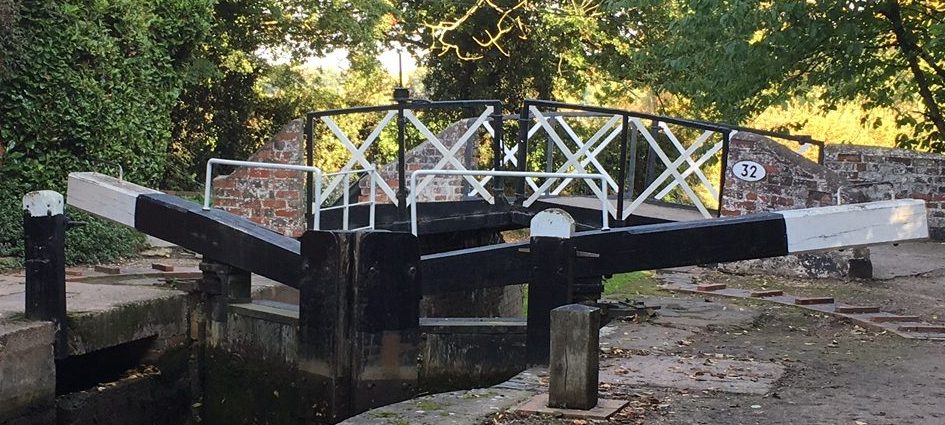Where is Lapworth? Lapworth is situated some 5 km north of Henley in Arden in Warwickshire near junction 16 of the M40 motorway. The settlement lies between the A3400 forming the western boundary and the Grand Union Canal to the east with the greatest concentration of population in Kingswood close to the railway and the station. Another canal, the Stratford Canal, cuts through Lapworth entering from the west on its way from Kings Norton. The location of Lapworth can be viewed here.
What’s in a name? We start our journey into the history of Lapworth by looking at the parish name. The name ‘Lapworth’ is generally considered to be of Anglo-Saxon origin making its first appearance in a very early medieval document dated to AD 816. Here the name appears as ‘HLAPPAWURTHIN’ and it also appears in the form ‘LAPPAWURTHIN’ at this time.
At the time of the Norman Domesday Survey of 1086 it is recorded in a different form as ‘LAPEFORDE’. This form is not repeated later on. One can only assume that the recorders were reflecting on their crossing of the brook which flows through the parish from the west and perhaps not recording with great comfort their fording of the brook flowing down the Tapster valley.
In the late 12C the name appears as ‘LAPPEWRTHE’ (and ‘LAPPEWURTHE’) in documents including the Pipe Rolls of Warwickshire dated to 1197. By the 13C the name begins to take on a more familiar form appearing as ‘LAPWURTH’ in 1236 in the Warwickshire Feet of Fines (1195-1284) and as ‘LAP(P)WRTH’ c. 1280 & 1281. From c. 1275, the more familiar ‘LAPWORTH’ was being used with variations of spelling very common throughout the 14C to 16C as in ‘LAPPEWORTH’ and ‘LAPWWRTH’ and as ‘LAPWORTHE’ in an Elizabethan document, dated to 1580.
Pronunciation of the name Pronunciation of the name ‘Lapworth’ today tends to sound both elements of the name with equal emphasis. In times past it was more frequently heard as “Lapputh”, a sounding of the word heard in the late 19C and still not unfamiliar to some today.
The place name ‘Lapworth’ has two elements ‘Lap’ and ‘worth’. The meaning of the two elements should be relatively straightforward but research shows that the overall interpretation of the name is open to debate with a number of options presenting an interesting challenge as to its interpretation.
The first element, ‘Lap’, originates from the Old English (OE) ‘Lappa’ (or ‘Laeppa’) which means ‘a lap, the skirt of a garment’. This is most frequently taken to mean ‘a border, boundary or edge’ – a topographical term. The caution – caveat – has to be made that the first element of a place name can also be a personal name and this will be returned to later.
The second element of the place name ‘worth’ is derived from ‘worthin’ (also ‘worthign’ or ‘wurthin’) which means ‘an enclosure’. This is usually a small place with a homestead, possibly fenced about or ‘enclosed’ in some way and often in a remote place.
Lapworth was a remote place in the former Forest of Arden and even by the 11C was little settled as shown by the Domesday Survey of 1086. Sir William Dugdale (the 17C antiquarian who wrote in detail about Warwickshire) states that Lapworth was remote from its Hundred, the Kineton (Kington) Hundred, and a detached part of this in the Fexhole Hundred.
In The Place Names of Warwickshire, Gover et al, suggest that the name can be interpreted as an ‘enclosure belonging to or found in … a detached portion, or district’. A possible difficulty with this interpretation arises with the fact that Lapworth was named prior to the wholesale division of land into manors and Hundreds; the latter happened from the 10C onwards.
If an interpretation of the ‘Lap’ element is taken to be ‘border, boundary or edge’, then such topographical features as the watershed between the rivers Trent and Avon, running through the north of the parish, would fit the interpretation; equally, an as yet unexplained late Iron Age linear feature, a possible boundary, running through parts of the parish close to Lapworth Street would also link to the ‘border or boundary’ interpretation; the parish was also on the boundary between the Saxon Hwicce to the south and west and Mercian Angles to the north in the Early Medieval period. It was also within, but on the border of the Diocese of Worcester (founded c. 679) and that of Lichfield. So is the interpretation of the name one that indicates that Lapworth was a small, isolated enclosure in the border country?
An alternative interpretation is possible if the first element in the place name, ‘Lap’, is taken to be an Anglo-Saxon personal name. This is not an unusual interpretation for place names in the midlands. ‘Lap’ would then become the personal name ‘Hlappa’. As such it would most probably be an OE pre 7C name to which second element ‘worth’, in OE ‘worthign’ or ‘worthin’, would have been added to give ‘Hlappa’s worthign’ – Hlappa’s enclosure (and homestead) in the Forest of Arden.
By Peter Hill (Lapworth Local History Group)
